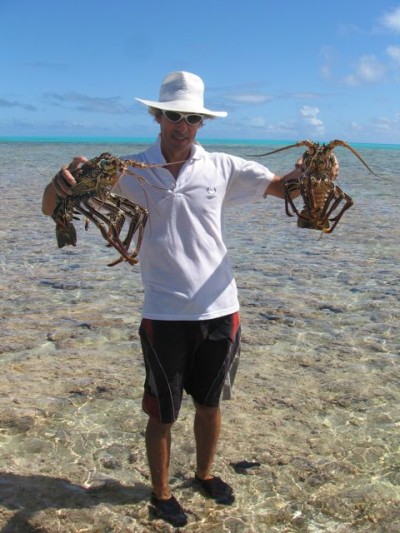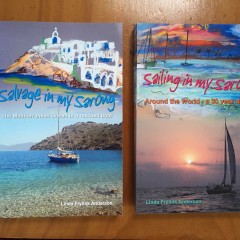
Sailing the Pacific
09 November 2010
07 November 2010
05 November 2010
26 October 2010
19 October 2010 | Somewhere between Fiji and Vanuatu
14 October 2010
14 October 2010
14 October 2010
14 October 2010
14 October 2010
03 October 2010
15 September 2010 | Vava'u, Tonga
02 September 2010 | Vava'u, Tonga
08 August 2010
29 July 2010
25 July 2010 | Bora Bora
20 July 2010
16 July 2010 | Moorea
16 July 2010 | Moorea, Society Islands
Beveridge Reef
08 August 2010
Isabelle

It was nearing the end of the third day of our passage from Palmerston Atoll to Tonga when we started having a closer look at the chart of the area. We noticed an intriguing looking reef. Beveridge Reef. With some research of some articles we had on board, we read that it is a landless rim of coral. Pristine. Uninhabited. Both our eyes were alight at the thought of such an adventure, an entire lagoon to ourselves! A few minutes later we had made a 90 degree left turn, and were on our way, 100 miles to Beveridge.
On the chart there was a note telling us that the reef is actually 3 miles north-east of where it's meant to be. This just added to the intrigue of such a place.
As we were approaching, we were welcomed by a humpback whale which launched its whole body out of the water, creating a massive splash as it fell back down. It then surfaced about 15 metres away from the boat. The water was so clear that we could watch it gliding underneath the surface.
On our charts, Beveridge Reef is simplified to something like a children's drawing but fortunately the navigating is easy with the pass wide and deep and the lagoon deep enough to be straight forward.
A rim of shallow turquoise water stretches all the way around the atoll, on one side bordered by the outer coral reef, on the other it encloses the deeper sea-blue lagoon.
We anchored in 9 feet on a sandy bottom. The water is so clear that when we dived in, we could see the anchor 100 feet ahead of the boat and well beyond that with perfect clarity. It's also a delicious shade of blue under there.
We had anchored in the SE corner of the lagoon and noticed that at low tide a part of the coral reef was exposed. We hopped in the dinghy and went to explore the reef but on the way, our dinghy engine cut out. We found ourselves drifting fast in the current that is created by the waters leaving the lagoon after the waves crash over the barrier reef. I was trying to get the anchor out but it�'s bag that had been tied very tight with numerous knots. We were drifting fast, away from our boat and away from the shallows. Jamie untied the oars and we took one each, using them as if we were in a canoe. It was exhausting paddling against the current but we really had no other choice, we had to keep up the pace. It took us a long time of intense paddling to get back to Dagmar who was only about 50 meters away. Our muscles were burning and we both realised then that we must take more precaution than usual as there would be no-one to rescue us out here, in the middle of the ocean, alone.
When Jamie had fixed the engine, we went out to the reef. We walked over about 100 meters of shallows after we had anchored the dinghy, careful not to step on the coral, sea cucumbers, giant clams and especially not the sea urchins, the spikes of which look like they could pierce your skin with no effort at all. Eventually we made it to the outer reef about 30 metres of which was exposed before the breaking waves.
We were walking close to the breakers and it was exhilarating, occasionally a big wave would come up, foaming around our knees, threatening to take us back into the ocean with it. We were looking for lobsters in the holes near the breakers. I had walked up ahead of Jamie when I heard �"I�'ve found one!�" I ran back to where Jamie was and watched as he tried to locate the lobster in a big dark pool, the waves breaking over his back, making it impossible to see. It escaped into a dark crevice, but we then had hope that we would find others.
A few minutes later, I spotted one. I was peering into a dark coral hole, between waves the water became clear and I could make out the faint outline of the lobster below. My heart jumped. I took my spear as it was quite deep and aimed then speared straight down. I knew I had got it because my spear was jiggling around as the lobster tried to free itself. Jamie then came along and reached down as I brought the spear up with the lobster on it. He grabbed the lobster but while the opening to the hole was big enough for the lobster to fit through, it wasn�'t big enough for the rock which the lobster had taken hold of and so we wrestled there a moment while we pried the lobster�'s arms off of the rock. We got it out and couldn't believe the size, probably about 3 kg.
After that, it seemed easy to find lobsters, we spotted about twenty others in the space of an hour or two, even one scrambling overland.
We took one more which was even bigger than the first. Unfortunately, what we didn�'t notice until we had speared it was that it was pregnant. It held two eggs just near the opening to its mouth. It is hard enough killing something, but something which it breeding life�. a sad realisation. Later, long after the lobster had died we opened the two eggs to find tiny little lobsters forming, their tails already there and one of them was still moving.
On the chart there was a note telling us that the reef is actually 3 miles north-east of where it's meant to be. This just added to the intrigue of such a place.
As we were approaching, we were welcomed by a humpback whale which launched its whole body out of the water, creating a massive splash as it fell back down. It then surfaced about 15 metres away from the boat. The water was so clear that we could watch it gliding underneath the surface.
On our charts, Beveridge Reef is simplified to something like a children's drawing but fortunately the navigating is easy with the pass wide and deep and the lagoon deep enough to be straight forward.
A rim of shallow turquoise water stretches all the way around the atoll, on one side bordered by the outer coral reef, on the other it encloses the deeper sea-blue lagoon.
We anchored in 9 feet on a sandy bottom. The water is so clear that when we dived in, we could see the anchor 100 feet ahead of the boat and well beyond that with perfect clarity. It's also a delicious shade of blue under there.
We had anchored in the SE corner of the lagoon and noticed that at low tide a part of the coral reef was exposed. We hopped in the dinghy and went to explore the reef but on the way, our dinghy engine cut out. We found ourselves drifting fast in the current that is created by the waters leaving the lagoon after the waves crash over the barrier reef. I was trying to get the anchor out but it�'s bag that had been tied very tight with numerous knots. We were drifting fast, away from our boat and away from the shallows. Jamie untied the oars and we took one each, using them as if we were in a canoe. It was exhausting paddling against the current but we really had no other choice, we had to keep up the pace. It took us a long time of intense paddling to get back to Dagmar who was only about 50 meters away. Our muscles were burning and we both realised then that we must take more precaution than usual as there would be no-one to rescue us out here, in the middle of the ocean, alone.
When Jamie had fixed the engine, we went out to the reef. We walked over about 100 meters of shallows after we had anchored the dinghy, careful not to step on the coral, sea cucumbers, giant clams and especially not the sea urchins, the spikes of which look like they could pierce your skin with no effort at all. Eventually we made it to the outer reef about 30 metres of which was exposed before the breaking waves.
We were walking close to the breakers and it was exhilarating, occasionally a big wave would come up, foaming around our knees, threatening to take us back into the ocean with it. We were looking for lobsters in the holes near the breakers. I had walked up ahead of Jamie when I heard �"I�'ve found one!�" I ran back to where Jamie was and watched as he tried to locate the lobster in a big dark pool, the waves breaking over his back, making it impossible to see. It escaped into a dark crevice, but we then had hope that we would find others.
A few minutes later, I spotted one. I was peering into a dark coral hole, between waves the water became clear and I could make out the faint outline of the lobster below. My heart jumped. I took my spear as it was quite deep and aimed then speared straight down. I knew I had got it because my spear was jiggling around as the lobster tried to free itself. Jamie then came along and reached down as I brought the spear up with the lobster on it. He grabbed the lobster but while the opening to the hole was big enough for the lobster to fit through, it wasn�'t big enough for the rock which the lobster had taken hold of and so we wrestled there a moment while we pried the lobster�'s arms off of the rock. We got it out and couldn't believe the size, probably about 3 kg.
After that, it seemed easy to find lobsters, we spotted about twenty others in the space of an hour or two, even one scrambling overland.
We took one more which was even bigger than the first. Unfortunately, what we didn�'t notice until we had speared it was that it was pregnant. It held two eggs just near the opening to its mouth. It is hard enough killing something, but something which it breeding life�. a sad realisation. Later, long after the lobster had died we opened the two eggs to find tiny little lobsters forming, their tails already there and one of them was still moving.
Comments
| Vessel Name: | Dagmar |
| Vessel Make/Model: | CAL 39 |
| Hailing Port: | Melbourne, Australia |
| Crew: | James Thomson and Isabelle Chigros-Fraser |
| About: | |
| Extra: |
Gallery not available
'Twenty years from now you will be more dissapointed by the things that you didn't do than by the ones you did do. So throw off the bowlines. Sail away from the safe harbour. Catch the trade winds in your sails. Explore. Dream. Discover.' -Mark Twain



